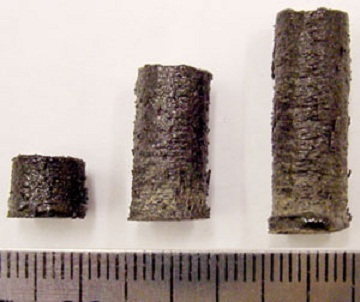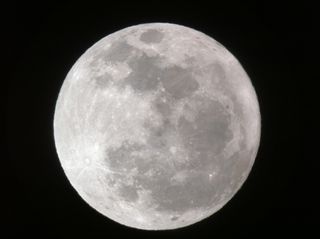3D Printer Could Transform Moon Dirt Into Lunar Base

For space scientists dreaming up a manned base on the moon, 3D printing with lunar dust looms as an attractive possibility. Such on-demand fabrication would allow astronauts to repair broken parts, manufacture spare ones and maybe even build structures, all out of the dirt scooped from under their boots.
In a new study involving artificial moon dust, engineers have shown that the technology is close to becoming reality.
With 10 pounds of simulated lunar dirt (or regolith) in hand, NASA officials approached researchers at Washington State University and challenged them to melt and resolidify the fake moon rock using 3D laser printing technology, which produces objects layer by layer based on a computer model.
The simulant is an expensive combination of silicon, aluminum, calcium, iron and magnesium oxides. Meant to mimic the properties of the regolith found on the moon, the powdery material had a particle structure resembling that of ceramics.
Because of their tendency to crack, ceramics can be tough to manipulate using 3D printers. But the WSU researchers, including husband-and-wife team Amit Bandyopadhyay and Susmita Bose, had previously demonstrated that ceramic-like material can be re-formed with an on-demand fabricator to create custom-made bone scaffolding.
For the new study, the researchers fed the raw simulant powder into a 3D printer, heating the material to high temperatures and printing it out in smooth half-millimeter (0.02 inches) layers to form small cylindrical shapes with no visible cracks. The structures that came out of the printer were about as hard as typical soda lime glass, the researchers explain in a study detailing the recent experiments in the Rapid Prototyping Journal. [10 Cool Moon Discoveries]
"It doesn’t look fantastic, but you can make something out of it," Bandyopadhyay said in a statement.
Get the Space.com Newsletter
Breaking space news, the latest updates on rocket launches, skywatching events and more!
While building a lunar habitat out of moon regolith might be a distant possibility, Bandyopadhyay indicated that repairing broken tools seems like the most feasible use for the technology in the nearer future. In addition to producing free-standing 3D objects, the team showed that the fake moon rock could be used to make a "superglue" to join together broken parts, Bandyopadhyay said.
3D printers that process lunar regolith could save on resupply costs for a manned base on the moon, which NASA reportedly been considering as a possible gateway to destinations farther out in space.
"It is an exciting science fiction story, but maybe we’ll hear about it in the next few years," Bandyopadhyay said. "As long as you can have additive manufacturing set up, you may be able to scoop up and print whatever you want. It’s not that far-fetched."
And beyond moon dust, the technology could be adapted to Martian soil, for manned missions to the Red Planet. Bandyopadhyay, however, said he hasn't been able to get his hands on any artificial Mars dirt yet.
Follow SPACE.com on Twitter @Spacedotcom. We're also on Facebook and Google+.

Join our Space Forums to keep talking space on the latest missions, night sky and more! And if you have a news tip, correction or comment, let us know at: community@space.com.

Megan has been writing for Live Science and Space.com since 2012. Her interests range from archaeology to space exploration, and she has a bachelor's degree in English and art history from New York University. Megan spent two years as a reporter on the national desk at NewsCore. She has watched dinosaur auctions, witnessed rocket launches, licked ancient pottery sherds in Cyprus and flown in zero gravity on a Zero Gravity Corp. to follow students sparking weightless fires for science. Follow her on Twitter for her latest project.